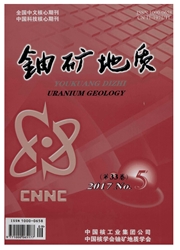

 中文摘要:
中文摘要:
邹家山铀矿床碱交代蚀变广泛发育,与铀成矿作用关系极为密切。笔者通过野外宏观地质调查和室内岩相学、电子探针分析、常量及微量元素化学分析等方法,初步查明该矿床碱交代型矿石的矿物交代蚀变顺序为钠交代、钾交代、硅质交代。碱性成矿热液先是富Na,而后富K,且两者成分相似,但富K热液更利于铀成矿。与正常碎斑熔岩相比,碱交代型矿石SiO2含量减少,K2O或Na2O、Al2O3、Fe2O3、MgO、P2O5、CaO和U、Th、Zr、Hf、Sm、Ti及REE含量明显增高。与钾交代型矿石相比,钠交代型矿石Rb和REE含量较少,稀土分异强。碱交代作用有利于副矿物蚀变并释放铀,有利于对地层中铀的萃取,有利于铀的稳定迁移。
 英文摘要:
英文摘要:
Alkaline metasomatites are widely distributed in Zoujiashan uranium deposit and have close re- lation with uranium mineralization. Based on the study of field geological survey, petrographic methods, element chemical analysis and EPMA, etc, the alteration in alkaline metasomatic ore was found in the order of sodium metasomatism, potassium metasomatism and silica metasomatism. The alkaline hydrothermal fluid of mineralization is rich in Na at first and then rich in K, and quite similar in orther chemical composition, but the K rich one is more favourite for the metalization. Compared with the normal por- phyroclastic lava, the alkaline metasomatic ores in lower in SiO2, but higher in K20 or Na2O, Al2O3, Fe2O3, MgO, P2O5, CaO and U, Th, Zr, Hf, Sm, Ti, REE. Compared with potassium metasomatic ore, the sodium metasomatic ore is with high ELREE/EHREE ratio and lower Rb and REE. Because alkaline metasomatism is beneficial to release uranium from accessory mineral and bring out uranium from rocks, therefore it is very important to the migration and precipitation of uranium.
 同期刊论文项目
同期刊论文项目
 同项目期刊论文
同项目期刊论文
 期刊信息
期刊信息
